While dandelions are considered a pesky weed when they crop up on a lawn they have many benefits. They are a plant that attracts ladybugs and provides them with a source of nourishment, with the ladybugs in turn keeping pest populations such as aphids in check. Their long taproots aerate the soil and take minerals up into the plants which are returned to the ground when the dandelion dies. Dandelions can be eaten and studies have shown that they are rich in vitamin B,C, and D as well as iron, manganese, magnesium, zinc, and phosphorus.

Physical Characteristics
Flower | Seeds: At first glance, or from a distance, one would think that a Dandelion is only one single flower; however they would be wrong in their assumption. The Dandelion is actually composed of many different flowers; some say from 100-300 bright yellow, separate flowers that form together to make the illusion of one single flower.
The Dandelion has the ability to grow in many different types of land; they thrive in moist areas that have full sun but can also grow in the shade and where it is dry. This is due to the fact that the Dandelion produces a type of root called a “taproot” which is capable of going as deep as 3 feet into the soil, in order to find water, which makes it capable of surviving through dry spells.
Shape: The Dandelion’s stalks that the flowers grow on can reach as high as 2 feet tall. Also, the leaves can be as long as 14 inches long. The leaves of the Dandelion are “serrated” which means that they give off the appearance of having teeth.
Ecological Characteristics
The Dandelion originated in Eurasia but it has become naturalized throughout the United States and occurs in all 50 states. The Dandelion also appears in all Canadian provinces and in Mexico.
Relationship With Other Species
Non-human: The common Dandelion has many non-human uses and importances. In Yellowstone National Park, the Dandelion is important for nutrition for the grizzly bears during the summer time. In fact, the Dandelion is also consumed by deer and elk in the spring, summer, and fall in the meadows of the Rocky Mountains. The Dandelion is somewhat nutritional for the deer; providing the minimal amount of protein.
Humans: The entirety of the common Dandelion is edible, with a somewhat obvious exception; pesticides. If the Dandelion that you are about to eat has been sprayed with pesticides, like many of the Dandelions in your backyard, then you should not plan on eating them. Common uses for the dandelion in foods are with salads. Aside from food, the Dandelion has been used as medicine in some cultures, and has been used for thousands of years in chinese medicine.
All of these uses, food and medicine, are important for the entire ecosystem. By providing animals (and humans) with nutrition the Dandelion serves with great value.
Other Interesting Facts
-
Every year Americans spend millions on lawn pesticides to have uniform lawns of non-native grasses, and we use 30% of the country’s water supply to keep them green.
- Dandelion flowers are photosensitive; which means they bloom under the morning and close in the evening or in gloomy conditions.
- The dandelion is also an ingredient in root beer.
References
http://mydandelionisaflower.org/did-you-know/
http://simplesaurus.blogspot.com/2013/04/10-facts-about-dandelions.html
http://www.ehow.com/about_5374101_dandelion-flower.html
http://www.fs.fed.us/database/feis/plants/forb/taroff/all.html
http://www.infobarrel.com/media/image/124724_max.jpg
http://cf.ltkcdn.net/herbs/images/std/118616-312x385-Whole_Dandelion.jpg
Click here to go back to ES 203 Home Page.
Subjects of this Page:
- Physical Characteristics
- Ecological characteristics
- Relationship With Other Species
- Other Interesting Facts
Fun Facts
- Every part of the dandelion is useful: root, leaves, flower. It can be used for food, medicine and dye for coloring.
- Dandelions have one of the longest flowering seasons of any plant
- The name dandelion is taken from the French word “dent de lion” meaning lion’s tooth, referring to the coarsely-toothed leaves.
- Seeds are often carried as many as 5 miles from their origin!
ES 203: SPRING FLORA OF THE GREAT LAKES
You can highlight additional information here or add more related links.
• You can link to other LFC.com pages
• You can link to an outside url
• You can link to a files such as a pdf


